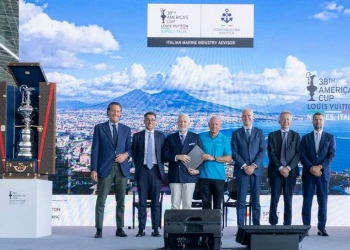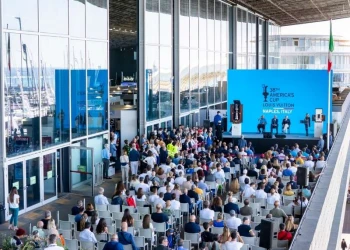
ETNZ, finding the edge in Barcelona
ETNZ, finding the edge in Barcelona
On a day when many would have looked at the sea-state and opted for a ‘maintenance day’ it was all systems go at Emirates Team New Zealand who were determined to take their AC75 ‘Te Rehutai’ out to experience conditions that the team haven’t sailed before in Barcelona in an AC75.
Up to two metre waves greeted the helm and flight team as they ventured out early to check the weather on a chase boat before the ultimate call to ‘go’ was made and just after midday, the Defenders of the America’s Cup were up and flying on a day where ‘caution’ was the watchword.
Straight out of the harbour entrance where it’s a notorious pinch point, particularly with a southerly swell running, Nathan Outteridge and Pete Burling called for the power on to punch through the waves and get enough speed for a two-board bear-away. With the stern noticeably squat, sat down resolutely keeping the rudder immersed, the mainsail was eased beyond angles we are ever used to seeing on an AC75 and with the J4-3 headsail, one of the smallest in the wardrobe, equally eased away, the Kiwis set off on a blistering downwind on starboard gybe.
Like watching Formula 1 in monsoon conditions, this was all about knowing when to back off and knowing when to take risks. Displacement mode was engaged happily upwind, no need to fly high and look like heroes as with waves this big in Barcelona, they have a habit of biting and causing the inevitable pitch-pole. Mainsheet was key, with big dumps as the traveller simply wasn't enough to induce the twist and spill out. So too, co-ordination with the jib trim with noticeable over-ease to allow the bow to come away on the bear-aways and even during gusts upwind - the comms onboard would have been white-hot between the two helms and two trimmers.

Only once did the recon unit record the team appearing to lose it after a bear-away and a heel to leeward but the problem was caught well before catastrophe. This was big boat, grand-prix sailing at its finest and all credit to the sailors for two and a half hours of utterly compelling viewing – something that every team up and down the Port Vell will be analysing for tips on heavy-weather technique.
Interestingly though, this was sailing at around the 21-knot mark at times and that’s the upper limit for racing in the 37th America’s Cup and who knows, these kinds of conditions could well be seen in both the Challenger Selection Series and the Match itself. The sea-state was at times extreme, but the recon team also recorded moments when the anemometer was down at just 10 knots, and it was at this point where the Kiwis hove-to and switched up a code on the jib to the J3-6 and started to look more comfortable although still, ultimately cautious.
Speaking afterwards, Blair Tuke, arguably the finest Flight Controller in the current America’s Cup world contextualised the day but could hardly hide just how much he and the team enjoyed it out there saying: “It was a great day for us, we've only got a few days left here in Barcelona and today presented some conditions we hadn't been out in before, so we wanted to get ‘Te Rehutai’ and the crew out in those conditions and yeah, we did that. Really successful day, the wind was quite volatile, up and down, and just a consistent messy state so it was a great test for the boat and the crew…We’d actually been out early in the morning just to look at the waves and then just before we left the wind really came in as a sort of expected to around about 20 knots, the toughest part actually is around the around the breakwater so we want to make sure we just get out the entrance safely so we were just checking that part and made the final call to go, got through and the conditions were as expected out there - a real challenge for us and the boat but a huge amount of learnings as a group and really successful day.”
And Blair continued: “You're learning everyday but those days even more so. We all love it in those conditions, really pushing ourselves and the boat, we've got a lot of trust in the crew and in the boat and to push it like we did today was really pleasing…we definitely had our moments out there, and they're all part of the learning so we'll look back in the data now and review but yeah, all-in-all, a great day.”
Seeing the AC75 pushed to its outer performance limits is clearly where the Kiwis are comfortable and as the only team on the water today, the question arose as to whether the psychological advantages were building in. Blair kept it cool saying: “There’s only a couple of teams with the big boat and you know in these conditions the big boats are obviously a little bit easier and it’s something that we've sailed back home in relatively big waves, so it was nice to go and continue to build on. We've got our programme here and we're trying to get the most out every day we can and today was a good day for us.”
Impressive all round, Emirates Team New Zealand will be back on the water again on Tuesday for more of the same – some of the most defining images of the first generation AC75. (Magnus Wheatley)
On-Water Recon Unit Report – Emirates Team New Zealand: Emirates Team New Zealand braved a forecast of big seas and potential strong winds for Barcelona today to gather valuable insight into how their last-generation AC75 would perform in such conditions. After rolling out at 1030 the Kiwi yacht was rigged and launched by 1112. While this was going on the afterguard of the crew went by chase boat to check out the conditions they could expect outside the harbour. Later, the scheduled dock-out time of 1200 was pushed back to 1220 to allow time for another chase boat sortie to recheck the sea state given the arrival of around 15 to 20 knots of gusty southerly breeze.
The Recon team also ventured outside the harbour entrance where we experienced a horribly confused sea state with waves heights between 1.7 and 2.0 metres. Still happy that conditions were sailable, the sailors returned to the base where the AC75 docked out at 1220. The crew hoisted sails – M2-3 mainsail and J4-3 headsail – in the shelter of the inside basin of Port Vell before sailing out of the harbour at 1240.
Soon after the boat's bow was punching through the steep chop as it accelerated to take-off speed. Moments later it made a sharp two-board bear away to head off downwind. The difficult sea state made it impossible for us to follow closely but it appeared that the crew were sailing conservatively on port gybe – often using two-boards – but were able to single foil on starboard.
Understandably, given the conditions, the boat looked less under control than it normally did and there were plenty of touch and go gybes and several straight-line splash downs.
With the breeze backing off as low as 10 knots around 1300 the team switched headsails at 1335 from the J4-6 to the J3-6. After this change the boat looked much more comfortable in flight – although the sea state still made tacks and gybes difficult, and the crew were still often using two boards on both gybes downwind. There was one precarious moment late in the session where the boat appeared to stall after setting off after a short stop and ended up heeled steeply for 10 seconds before the crew got the boat under control (see photo below). Time was called at 1425 with the boat sailing into the harbour before sails were dropped in the inner basin by 1445 ahead of dock in at 1455. Another sailing session is scheduled for tomorrow, Tuesday October 24.





